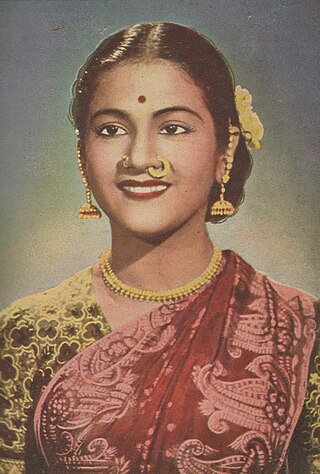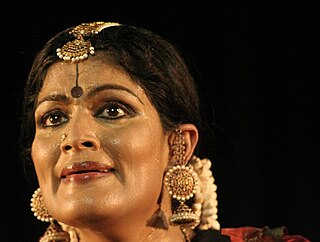Related Research Articles

Bharatanatyam is an Indian classical dance form that originated in Tamil Nadu. It is one of eight Indian classical dance forms recognized by the Sangeet Natak Akademi, and expresses South Indian religious themes and spiritual ideas, particularly of Shaivism and in general of Hinduism.

Rukmini Devi Arundale was an Indian theosophist, dancer and choreographer of the Indian classical dance form of Bharatanatyam, and an activist for animal welfare.
Ragamala or Raga mala can refer to:
Rukmini Vijayakumar is an Indian dance choreographer, Bharatanatyam dancer, and actress from Bengaluru. Along with her performances on stage, she has appeared in films such as Ananda Thandavam (2009), Bhajarangi (2013), Kochadaiyaan (2014), Final Cut of Director (2016), Kaatru Veliyidai (2017), and Sita Ramam (2022).
Alarmel Valli is a leading Indian classical dancer and choreographer and the foremost exponent of the Pandanallur style in the Indian classical dance form, Bharatanatyam. She is widely acclaimed for her ability to turn traditional grammar into deeply internalized, personal dance poetry.
Smitha Madhav is a Carnatic Classical Singer and Bharatanatyam Dancer. Carnatic music is a system of music commonly associated with the southern part of India and one of the two main classifications of Indian Classical Music.

Joyce Kakariyil Paul is a Bharatanatyam dancer, exercise physiologist, and anthropologist from India. Classically trained in Bharatanatyam from Kalakshetra, she is known for her technical acumen, rigour, and precision. Paul had her initial dance training under Padmashri Leela Samson and further training under Prof C.V. Chandrasekhar and Janardhanan Sir among others. She has trained in Mohiniattam, the classical dance of Kerala. In 2003, she founded Arpan Performing Arts, an organization dedicated to promoting the folk and classical traditions of India, where she currently serves as its creative director.

Kalanidhi Narayanan was an Indian dancer and teacher of Indian classical dance form of Bharatnatyam, who was the early non-devadasi girl to learn the dance form and perform it on stage in the 1930s and 1940s. After a brief career in the 1940s, she returned to dance in 1973 and became a notable teacher of abhinaya.

Kumari Kamala is an Indian dancer and actress. Initially featured as a child dancer, Kamala appeared in almost 100 Tamil, Hindi, Telugu and Kannada films throughout her career. In the 1970s, she became a teacher of the Vazhuvoor style of dance in which she specialises.

Saroja Vaidyanathan is a choreographer, guru and a notable exponent of Bharatanatyam. She was conferred the Padma Shri in 2002 and the Padma Bhushan in 2013 by the Government of India.

Savitha Sastry is an Indian dancer and choreographer best known as an exponent of Bharatanatyam. She is known to experiment with the format of traditional Bharatanatyam by using the techniques of Bharatanatyam to showcase theme-based productions based on novel stories, not based on Indian mythology or religion. Her innovations have been described as 'path breaking' by critics. and she is considered to be a 'renaissance architect' who 'holds the distinction of being the dancer to have brought out a revolution in the way Bharatanatyam is presented after Rukmini Devi Arundale'.

Soul Cages is a solo Bharatanatyam Dance Theatre production choreographed and performed by Savitha Sastry. It is based on a short story of the same name by AK Srikanth, and featured music by the Chennai-based music composer Rajkumar Bharathi, the great grandson of the veteran poet Subramania Bharathi. The production premiered on 28 January 2012 at New Delhi’s Kamani Auditorium, and has since played in over 20 cities. The presentation was received with critical and popular acclaim.

Ashwini Bhat is an artist, based in Northern California. She is known for her sculptures.

Parshwanath Upadhye is an Indian classical dancer, choreographer and teacher. He is trained in the traditional Mysore style of Bharatanatyam.

Geeta Chandran is an Indian Bharatanatyam dancer and vocalist. Trained in Carnatic music, she is a visionary and celebrated artist in Indian classical Bharatanatyam, recognized for her work in theatre, dance, education, videos and films.

Sheema Kermani is a Pakistani dancer and social activist. She is the founder of Tehrik-e-Niswan Cultural Action Group. She is also an exponent of Bharatanatyam dance. She is also a renowned classical dancer, choreographer, dance guru, theatre practitioner, performer, director, producer, and TV actor based in Karachi, Pakistan. She advocates on culture, women's rights, and peace issues.
Meenakshi Srinivasan is an Indian classical dancer and choreographer, and an exponent of the Pandanallur style of Bharatnatyam. She trained under Alarmel Valli and is considered among the most promising soloists of the younger generation of dancers in this traditional style.
Center for Performing Arts is a performing arts organization based in Minneapolis, Minnesota, United States. It was founded in 1995 by Jackie Hayes.
References
- 1 2 3 Pioustin, George (January 22, 2015). "Tribune to Mother Earth – Ragamala Dance Company's production blended dance and kolam designs on stage". The Hindu . Chennai, Tamil Nadu, India. p. E3. Retrieved April 10, 2021.
- 1 2 Preston, Rohan (September 22, 2006). "onstage – Moving Indoors: Ragamala's retelling of a grand Hindu epic has been to Bali and back". Star Tribune . p. F8.
- 1 2 Preston, Rohan (September 23, 2011). "onstage – 'Earth' dance: Ragamala Dance expands its repertoire with a world premiere based on Indian art and philosophy". Star Tribune . p. E7.
- 1 2 "Ragamala combines Indian dance, Japanese drumming". The Star Press . Muncie, Indiana. February 26, 2004. p. 7.
- 1 2 Preston, Rohan (June 2, 2002). "onstage – News & Notes: Delayed trip to Russia is back on for Ragamala". Star Tribune . p. F3.
- 1 2 3 Palmer, Caroline (April 28, 2018). "A Family Dances with Devotion – Review: Ramaswamy sisters bring nuance and mood to this Ragamala Dance Company Show". Star Tribune . p. E3.
- 1 2 Wren, Celia (November 1, 2018). "Theater & Dance- Dance company Ragamala elevates Snakes and Ladders to spiritual heights". The Washington Post . Washington, D.C. Retrieved March 26, 2020.
- 1 2 3 4 5 Steve, Marsh (March 15, 2022). "Mpls/St. Paul Magazine: "What Ragamala Dance Company's New Show Says About Life and Death" - Ranee Ramaswamy, along with her daughters, Aparna and Ashwini, are using Bharatanatyam, an ancient Hindu dance form, to help us understand modern life... and death". Mpls.St.Paul Magazine. MSP Communications. Retrieved July 30, 2022.
- ↑ Mathur, Preeti (2019). From Seven Rivers to Ten Thousand Lakes – Minnesota’s Indian American Community. Minnesota Historical Society Press. p. 63.
- 1 2 "Life- Ragamala Dance to perform at Miami". The Journal News . Hamilton, Ohio. March 30, 2012. p. D3.
- ↑ Steele, Mike (January 11, 1994). "A beautiful oasis- Ragamala Dance Theater adds grace to poetry". Star Tribune . p. 3E.
- ↑ Steele, Mike (December 28, 1994). "Dance – New works cross many boundaries". Star Tribune . p. 1E, 6E.
- 1 2 Espeland, Pamela (May 13, 2014). "Indian Fusion – Ancient meets modern at the Walker this week, as our renowned Indian dance troupe Ragamala joins forces with a New York Jazz Star". Star Tribune . p. E1, E3.
- ↑ Macauley, Alastair (March 11, 2011). "Transcandence and Mystery in Tiny Gestures". The New York Times . Retrieved April 12, 2021.
- ↑ Shapiro, Linda (July 1, 2012). "Ragamala Dance (and its wonder women) at 20". Dance Magazine . Retrieved April 12, 2021.
- ↑ Burke, Siobhan (August 8, 2014). "Dance Review: Sacred Music and Movement With an Infectious Beat". The New York Times .
- 1 2 Datta, Tiasha (December 10, 2020). "Ragamala Dance Company transcends culture, time, and space in Meany on Screen performances". The Daily of the University of Washington . Seattle, Washington: University of Washington . Retrieved April 13, 2021.
- ↑ Warnecke, Lauren (January 12, 2019). "In Harris Theater debut, Ragamala Dance shows the metaphor and mythology in a board game – and is pure fun to watch". The Chicago Tribune . Chicago, Illinois . Retrieved March 26, 2020.
- ↑ "Best Dance Company – Ragamala Dance Company". City Pages . Minneapolis, Minnesota. 2018. Retrieved March 26, 2020.